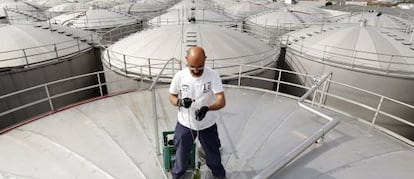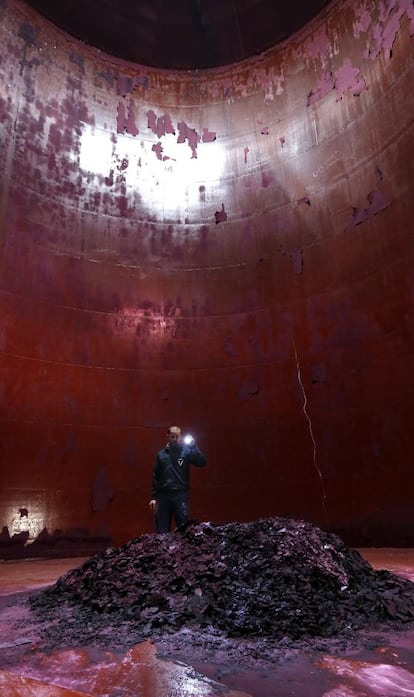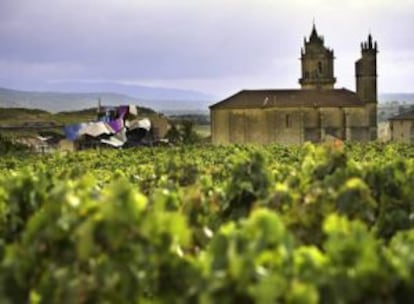Is your French wine made in Spain?
Millions of liters of Spanish reds and whites get exported for bottling in other countries


A thick hose pumps 27,000 liters of white wine into a tanker truck that will soon travel from the Spanish region of Castilla-La Mancha to southern France.
Supervising the operation is Ramón, the trucker in charge of making sure that the load arrives in good condition. We are in Virgen de las Viñas, a large wine and oil cooperative located in Tomelloso (Ciudad Real).
What do we do with all those millions of hectoliters if we don’t drink them here in Spain?”
Juan Antonio Mompó, Arenal Trading
Every day, a million liters of bulk wine leave this estate en route to France, Italy and Germany.
“Most of the wine from La Mancha gets sent abroad,” says Ramón, who has been crisscrossing Europe with truckloads of wine for the last 25 years. “The problem is, it’s getting cheaper all the time.”
The trucker’s analysis is right on target, and it is a cause for concern for an industry whose exports have skyrocketed in recent years, yet whose revenues have dropped.
Last year, Spanish wine exports grew 22.3 percent from 2013, reaching over 2.28 billion liters and making Spain the world’s largest exporter, according to the Spanish Wine Market Observatory (OEMV).
Yet revenues from wine exports fell 3.2 percent, and the average selling price for a liter of wine slumped by as much as 20.6 percent. In 2014, Spain exported wine at €1.11 a liter, compared with €5.37 charged by France.
Spaniards make a lot of very good wine, but they sell it at the price of a bad wine. This same product is later commercialized by France and Italy at much higher prices.

The explanation for Spanish wine’s inability to fetch the market prices that experts agree it deserves is manyfold: a lack of good salespeople with language skills, weak distribution networks, over-abundant harvests and low-paying customers.
Another reason is the fact that Spain specializes in bulk wine. Unbottled Spanish wine is used by bars, supermarkets and sangria makers across the globe. Last year, Spain sold 1.25 billion liters of bulk wine, a 38-percent rise from the previous year. Three-fourths of this amount gets sent to France, Germany, Portugal and Italy.
Rafael del Rey, director of the OEMV agency, explains that some of the Spanish wine that makes its way to France “gets re-exported as Spanish wine, or turned into alcohol, or mixed with French wine, while in Germany it is used to make sparkling wine.”
Last year, the price of a liter of Spanish bulk wine was €0.40, compared with €2.48 for New Zealand, €0.71 for Italy and €1.24 for France.
Castilla-La Mancha, where half of Spain’s wine is produced, perfectly illustrates the problem. In 2014, regional production grew 51.8 percent and prices fell 34.9 percent to €0.50 per liter, compared with €8.45 in the Canary Islands and €3.48 in the Basque Country.
The 2014 figures are particularly bad due to an extraordinarily plentiful harvest. The abundance caused prices to plummet. The hyper-sensitive global market sensed Spanish winemakers’ urgency, and negotiated prices down.
It is much easier to sit in you office and wait for a French agent to come to you with an order, than to go knocking on doors in Singapore”
Rafael del Rey, director Spanish Wine Market Observatory
“We went out to market very quickly and very needily, as though we wanted to get rid of the wine,” says Del Rey. “Exports went very fast, and that is not something you improvise.”
The Virgen de las Viñas cooperative illustrates the strengths and weaknesses of Spanish wine in general and wine from La Mancha in particular. This place boasts about being the largest wine cooperative in Europe, and sells 90 percent of its production in bulk. Eighty percent is exported to France, Italy and Germany.
Nearly everything here is superlative. Massive metal vats hold much of the 160 million liters that were obtained from the last harvest. A tangle of hoses on the floor transfers the liquid from one container to the next until it reaches the tanker truck.
The cooperative, which keeps growing, is now focusing efforts on selling more bottled wine and less table wine.
“We have increased bottling, but it is utopian to think that we can bottle all the wine of La Mancha”, says cooperative president Rafael Torres, who has personally seen production soar and revenues fall during his 14 years at the helm.
Too much of a bad thing?
“The French commercialize our wine at two or three times the price that we sell it at. We lack a brand. People associate wines from La Mancha with large quantities and poor quality. We have wines that can compete with the best from France, but it will take time and strong government campaigns to prove it,” he says.
Adding to these woes is a drop in domestic demand, partly due to changing consumer habits since 1989. Also, distillation subsidies ended in 2011.
If a country is drinking less wine, distilling less of it, yet producing as much or more than before, it needs to find other countries that will buy the surplus.
If we drank as much wine as the Italians or the French do, a lot of our problems would go away”
Rafael Torres, president Virgen de las Viñas cooperative
“If we drank as much wine as the Italians or the French do, a lot of our problems would go away,” Torres laments. “There is no wine culture here, young people no longer go out for a glass or two the way they used to.”
Now, Virgen de las Viñas is planning to join other cooperatives, open new bottling plants, and launch commercial agencies in export destinations.
There are areas where the situation is not as bad as it is in Castilla-La Mancha. In La Rioja, renowned worldwide for its quality bottled wines with “designation of origin” labels, winemakers understood long ago that it is better to produce less and sell at higher prices.
Yet in Spain, even bottled products still sell at far lower prices than other exporting countries: €2.06 a liter versus €4.66 a liter in France.

“It’s not a question of quality, but of perception,” notes Juan Park, research director at the London-based marketing, strategy and research service Wine Intelligence. “Spain says it has quality wine, yet it sells at €0.40. If it wants to be quality, it needs to make decisions.”
Just a half-hour drive from Virgen de las Viñas, in Manzanares, there is another winemaker that is the opposite of the Tomelloso macro-cooperative. Vinícola de Castilla only sells bottled wine, and production is a mere 10 million bottles a year. Two-thirds of these get sold to clients in 45 countries.
Of the 26 people on staff, 12 are sales agents and four of them travel the world with a bottle under their arm. Managers say that, just like other winemakers, they have trouble finding employees who are prepared to travel and whose English is good enough to represent the company abroad.
“We could sell more, but we would have to lower our prices,” says director Alfonso Monsalve, who believes that the key lies in producing less and even defends setting production limits. “I know it’s not a popular choice, but...”
A quest for new clients
Bottling means mostly finding new clients, knocking on doors and traveling the world. And that is precisely the industry’s weakness, says Del Rey, of Oemv.
“It is much easier to sit in you office and wait for a French agent to come to you with an order, than to go knocking on doors in Singapore,” he says. “The sales agent who goes abroad finds clients, but also finds out what people are drinking outside our borders, whether they prefer sweet wines, red or white, in a bottle or in a plastic bag, and that kind of information is essential in order to adapt our supply.”
Reducing the harvests is a recurring theme among industry experts, but it is also a touchy issue. Around 400,000 families make a living from winemaking in Spain, not counting indirect activities.
Juan Antonio Mompó of Arenal Trading, an alliance of more than 25 wineries, is a voice of reference in the sector. He compares the situation with sun-and-sand tourism versus quality tourism.
“It’s obvious that we all prefer quality, but what do you do with all the thousands of hotel beds in Salou? Or in other words, what do we do with all those millions of hectoliters if we don’t drink them here in Spain?”
Spain says it has quality wine, yet it sells at €0.40. If it wants to be quality, it needs to make decisions”
Juan Park, research director at Wine Intelligence
Yet Mompó feels that being the kings of bulk is not necessarily a bad thing, because bulk is just a form of transportation. The real issue is, what type of wine is it and what price is it being sold for? He explains that the global trend these days is to bottle the wine at their destination countries: Britain is bottling Australian wine and German supermarkets are bottling imported wine. Mompó also underscores the environmental upside of bulk transportation, which reduces emissions.
While the experts ponder the matter, Ramón has already started driving towards southern France with his tanker truck. Once he has delivered his load, he will relax by having a drink at a local bar.
“They will serve me wine just like the one I delivered, but mixed up with French wine and in a French bottle,” he notes. “That’s the way this business works.”
Tu suscripción se está usando en otro dispositivo
¿Quieres añadir otro usuario a tu suscripción?
Si continúas leyendo en este dispositivo, no se podrá leer en el otro.
FlechaTu suscripción se está usando en otro dispositivo y solo puedes acceder a EL PAÍS desde un dispositivo a la vez.
Si quieres compartir tu cuenta, cambia tu suscripción a la modalidad Premium, así podrás añadir otro usuario. Cada uno accederá con su propia cuenta de email, lo que os permitirá personalizar vuestra experiencia en EL PAÍS.
En el caso de no saber quién está usando tu cuenta, te recomendamos cambiar tu contraseña aquí.
Si decides continuar compartiendo tu cuenta, este mensaje se mostrará en tu dispositivo y en el de la otra persona que está usando tu cuenta de forma indefinida, afectando a tu experiencia de lectura. Puedes consultar aquí los términos y condiciones de la suscripción digital.








































